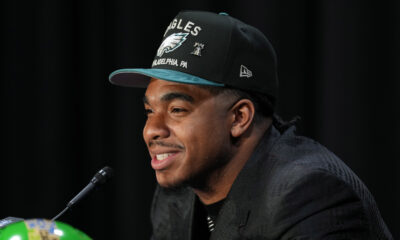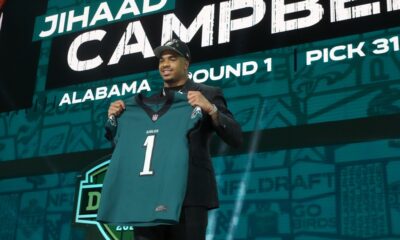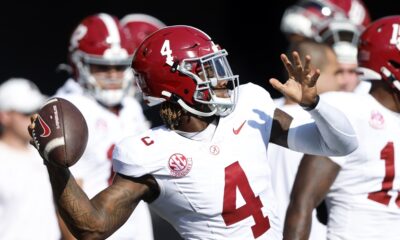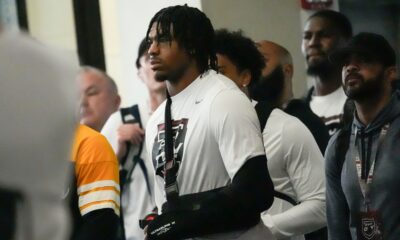He was bounced from the National Football League, ran out of Tennessee and fired at Southern California. Practice was the lone option of taking Alabama’s mind off a horrible loss to Auburn. No one understood why Lane Kiffin arrived at Tuscaloosa in December 2013, no one but Alabama’s head coach Nick Saban. Kiffin wanted to rest. A moment away from cameras and microphones was paradise for him. He was dismissed from his “dream job” in the worst possible way, being called off a team bus after USC’s 62-41 loss to Arizona State in 2013. Saban reached out to Kiffin, and he responded by coming to Alabama as an offensive consultant.
Eight days in title town was exactly what Kiffin needed. He toured the facilities and witnessed Saban’s process first-hand. He kept a low-key attitude, providing his insight when needed. Kiffin at Alabama wasn’t conceived as a coaching idea, but his offensive paralysis is what won the 39-year-old to Saban. Kiffin was hired on Jan. 10, 2014. Alabama fans endured conflicting emotions, but Saban believed he made the correct move.
“I got beat up like a drum because of the hire,” Saban said. “I mean, if I thought what you all thought when I hired the guy [Kiffin], he probably wouldn’t be here. Maybe that was the assumption because nobody thought it was a good hire all of sudden something bad. I don’t know. I thought it was a good hire. No one else did.”
Saban has begged previous coordinators to open up Alabama’s offense. Jim McElawin and Doug Nussemeier both excelled, but Kiffin has brought a different dynamic to the table.
The Crimson Tide has achieved balance offensively. It’s averaged 37.1 points and 490.5 yards per game. Alabama’s offense on third down has been stellar, registering a 54 percent conversion rating. The Crimson Tide has reached 40+ points in seven games, six of them have come inside Bryant-Denny Stadium. No timetable stands on when Kiffin will be a head coach again, but he’s been manipulating offenses since his days at USC as a tight end/receivers coach (2001-02).
Kiffin at USC (2001-06)
Lane Kiffin was involved in college and NFL football early in his career. He was an assistant at Fresno State and Colorado State. Kiffin was a quality control assistant for the Jacksonville Jaguars. His big break came in 2001, when USC’s head coach Pete Carroll hired Kiffin as a tight ends coach. Kiffin embraced more responsibilities in 2002-04, becoming USC’s wide receivers coach and quarterbacks coach. His connection with players promoted him to offensive coordinator, alongside Steve Sarkisian in 2005.
Kiffin’s offensive scheme is based on getting playmakers the ball in space. He accomplished it in 2005 and it paid off for USC. The Trojans dismantled opposing defenses, averaging 49.1 points and 579 yards offensively. Matt Leinart became Kiffin’s first 3,000-yard passer. He completed 65.7 percent of his passes for 3,815 yards, 28 touchdowns and five interceptions in 2005.
Kiffin loves to air it out, but he isn’t afraid to pound the rock. Reggie Bush and LenDale White both totaled 1,000 rushing yards in 2005. Bush recorded 1,740 yards and 16 touchdowns. White collected 1,302 yards and 24 touchdowns (led the nation).
Receiver Dwayne Jarrett had a monster year under Kiffin in 2005. He brought in 91 passes for 1,274 yards and four touchdowns. Steve Smith put in 60 receptions for 957 yards and six scores.
2006 would see much of the same from Kiffin and USC’s offense. John David Booty topped 3,000 passing yards (3,347), Jarrett had a second 1,000-yard receiving season (1,015, 12 touchdowns) and Smith made the century mark, totaling 1,083 yards and nine touchdowns.
Kiffin brought USC a No.1 recruiting class in all three seasons as its recruiter. He posted a 23-3 (88 percent) record in his tenure with the Trojans. Kiffin witnessed three Heisman winners, Carson Palmer (2002), Matt Leinart (2004) and Reggie Bush (2005, but vacated), captured two AP national championships in 2003-04 and collected four Pac-10 titles (2002-04, 2006).
Rocky Top Transition—Kiffin at Tennessee (2009)
Kiffin didn’t fare well with the Oakland Raiders (2007-08), despite having a $4 million contract. He left the NFL and returned to college football in 2009. The Southeastern Conference gets the best of everything. Knoxville, Tenn., snatched Kiffin up and brought him to Neyland Stadium. Tennessee had a Hall of Fame coach in Phillip Fulmer, but it felt that Kiffin could usher in a new chapter. The 33-year-old signed a $2 million contract with hopes of getting the Volunteers to compete for national title.
A 7-6 record is average. It’s bowl worthy, but average. Tennessee fans weren’t enthused, yet Kiffin posted a better season than Fulmer’s 5-8 record in 2008. The Volunteers offense vastly improved under Kiffin. Kiffin’s play calling increased Tennessee’s offensive output by more than 60 percent. The Volunteers suffered some low points, including a 12-10 heart-breaking loss to Alabama in 2009, but found ways to bounce back. Tennessee accomplished key wins against Georgia, South Carolina and Kentucky.
Jonathan Crompton wasn’t Matt Leinart or John David Booty, but Kiffin made an NFL prospect out of him. Crompton completed 58.3 percent of his passes. He finished 2009 with 27 touchdowns and 13 interceptions. Crompton was selected in the fifth round (168th pick) of the 2010 NFL Draft by the San Diego Chargers. He is now a starting quarterback in the Canadian Football League for the Montreal Alouettes.
Return to California—Kiffin’s second stint at USC (2010-13)
Sean “P. Diddy” Combs never thought he would collaborate on a song with Holly Brook “Skylar Grey” Hoffman. Combs and Grey released a hit single “Coming Home” on Nov. 21, 2010. 10 months prior, USC’s Pete Carroll left for the NFL. He took a head coaching position at Seattle. Kiffin seized an opportunity and returned to the atmosphere that made him a household name. 2010 spelled doom for the Trojans. Issues that occurred five years ago, involving Reggie Bush and two sports agents finally caught up with USC.
The NCAA stripped numerous wins, two national titles, a conference championship and a Heisman Trophy from the program. Scholarships came at a premium, yet it didn’t stop Kiffin from running an offense. The Trojans finished 8-5 in 2010. USC defeated California 48-14 and rival UCLA, retaining the Victory Bell. 2011 was a huge year for USC. It finished 10-2, (7-2 in the Pac-12), but a two-year bowl ban kept it from reaching postseason play.
2012 was coined as USC’s year. Sports writers and college football analysts picked the Trojans as an early favorite for a national title. Matt Barkley could have gone to the NFL after his junior season. He dropped jaws, completing 69.1 percent of his passes for 3,528 yards, 40 touchdowns and seven interceptions in 2011. Barkley returned to USC as a senior. The bowl ban was lifted and the Trojans offense was littered with talent, yet the dream did not blossom. USC limped to a 7-6 season. Barkley injured his shoulder against UCLA.
Kiffin needed a reset button in 2013, but USC didn’t give him an option. The Trojans started the season 3-2. Athletic director Pat Haden had enough of Kiffin and replaced him with Ed Oregeron. USC went 6-2 in its remaining games, resulting in a 9-4 finish under Oregeron. Clay Helton coached the Trojans in the Las Vegas Bowl, after Oregeron resigned.
Mishaps are a part of life. It’s about appreciating the good and improving all negatives. Kiffin hadn’t produced a 3,000-yard passer, a 1,000-yard rusher and a 1,000-yard receiver in five seasons (2005-USC). He achieved it in 2012. Barkley had 3,273 passing yards and 40 touchdowns. Curtis McNeal totaled 1,005 rushing yards and six scores. Marqise Lee recorded 118 catches for 1,721 yards and 14 touchdowns. Lee became Kiffin’s first receiver to win the Fred Bilenikoff Award in 2012. Barkley won the Wuerffel Trophy (2012) and was recognized as the CFPA National Performer of the Year in 2011.
An Unexpected Marriage—Kiffin at Alabama (2014-present)
Lane Kiffin loves conversations. Sometimes it works, and at times it has gotten him into trouble. Alabama’s defensive coordinator Kirby Smart may offer a rebuttal or two, but Nick Saban handles all the talking for the Crimson Tide. One thing for certain is that Kiffin knows who to learn under. He spent six years with Pete Carroll, so it’s not surprising to see him taking notes from Saban. Alabama fans and NFL fans share one common denominator, instant success.
What can you do for us? This is the question Crimson Tide fans pondered on as it saw Lane Kiffin in action as Alabama’s offensive coordinator in the summer. Alabama had its annual football fan day on Aug. 3, 2014 at Bryant-Denny Stadium. Coach Saban held a press conference inside the Mal Moore Athletic facility. Smart normally is the lone assistant Saban allows to speak, but Kiffin was granted an opportunity to address the media.
“I am very happy to be here at the University of Alabama,” Kiffin said in August. “I am excited and fortunate about the opportunity I’ve received. To sit here and be able to learn from Coach Saban is great. It’s one thing to see the process, but it’s another aspect to be involved with it.”
Kiffin is a competitor when it comes to being a head coach. He said it’s a dream that will come in time.
“I would love to return to being a coach, but right now it’s not about me or any prior events,” Kiffin said. “I’m about Alabama football and I’m ready to get started.”
A Quarterbacks Coach—Kiffin and Blake Sims
Blake Sims is Alabama’s unsung hero this season. His career began as a running back in 2010, before a transition occurred. He attempted 39 passes as AJ McCarron’s backup. Sims has silenced all critics as a first-year starter. He’s completed 64.8 percent of his passes for 3,250 yards (season record holder), 26 touchdowns and seven interceptions. Sims has engineered game-winning drives and game-saving drives all season for Alabama.
Sims is the underdog story, but so is Lane Kiffin. Kiffin recruited Sims to Tennessee in 2009. Fate would have Kiffin take a head coaching position at USC, causing Sims to flip his commitment to Alabama. Sims struggled at first, but remained with the Crimson Tide. It took four years, but Sims and Kiffin are united. Kiffin’s style has helped Sims improve as a passer. He’s used short throws to get him loose and deep passes to improve Sims’s arm strength.
Sims’s first big game was against Florida. It was his first test against a tough SEC opponent. Kiffin reached into his bag of tricks and dialed up Sims’s first touchdown pass of the contest. It was a shotgun, 4-receiver formation that had running back Kenyan Drake as a flex target. Alabama’s offensive line supplied protection and Sims fired a dart to Drake for an 87-yard touchdown.
“That play was all Kiffin,” Sims said to al.com
Sims ended the matchup against Florida with 445 passing yards and four touchdowns.
He prefers a press box, but Saban has had Kiffin on the sidelines all season. It’s helped Alabama’s offense flow well, and it’s given Sims the confidence to make plays.
“Look at me. Let me help you.” This is what Kiffin says to Sims when he is having trouble against opposing defenses. Sims had a rough first half against Auburn. His two interceptions were a product of him not reading the Tigers defense properly. Sims’s started to focus more on Kiffin in the second half. His attention to details worked. Sims totaled four touchdowns in the second half, including two touchdown passes to Amari Cooper. Alabama defeated Auburn 55-44.
The Iron Bowl victory was classic, but Sims’s first coronation took place last week at the Georgia Dome. Kiffin settled him down after Sims’s suffered two communication issues in the first quarter. He then went on to accomplish something that no other Alabama quarterback has done. Sims completed 85.2 percent of his passes (23/27) in the SEC title game against Missouri.
His mark stands as a conference championship game record. Sims finished with 262 yards and two touchdowns. His daughter, Kyla smiled. Kiffin was the first to embrace Sims as he came to the sidelines late in the fourth quarter. Alabama defeated Missouri 42-13. It accomplished its 24th conference title. Sims was named MVP of the game.
Recognizing Playmakers—Amari Cooper, T.J. Yeldon and Derrick Henry
If any concerns remain about how good Lane Kiffin is? Look no further than Amari Cooper’s offensive output from 2013 to this season. Cooper had an amazing freshman year (59 catches, 1,000 yards, 11 touchdowns), but suffered a minor sophomore slump. He nursed a toe injury for much of the season and wasn’t on the same page with AJ McCarron often. Cooper ended 2013 strong with 45 receptions for 736 yards and four touchdowns.
A healthy Cooper and the addition of Kiffin have been great for Alabama. Dwayne Jarrett, Steve Smith, Robert Woods and Marqise Lee all totaled 1,000 yards receiving under Kiffin at USC. Cooper became Kiffin’s fifth receiver to reach this feat, securing 115 catches for 1,656 yards and 14 touchdowns.
Kiffin has used Cooper in every possible way this season. He’s caught short passes, deep passes and has even been featured in Alabama’s run game. Cooper has caught at least 8 passes in 11 games. Kiffin has guided him to being Alabama’s all-time leading receiver, totaling 219 catches for 3,392 yards and 29 touchdowns.
“Coach Kiffin has made this offense more player friendly,” Cooper said in August.
Cooper was the first to voice it, but Alabama’s offense as a whole has recognized it. He’s a primary target, but Kiffin has had success using Cooper as a decoy.
LSU and Missouri were two matchups that saw senior DeAndrew White open up more. He caught a critical 16-yard pass from Sims in the fourth quarter against the Tigers. White returned with a game-winning 6-yard touchdown reception in overtime. Alabama defeated LSU 20-13. Cooper collected 12 receptions for 83 yards against Missouri, but totaled two catches in the second half. White dismantled Missouri’s secondary with four receptions for 101 yards, including a 58-yard touchdown catch in the first quarter.
Amari Cooper has had a huge week. He’s the 2014 SEC Offensive Player of the Year, a Biletnikoff Award finalist and a Heisman Trophy finalist.
“Cooper is a hard worker,” Kiffin said. “He’s always asking questions. He wants to get better at his craft and be the best at his position. Cooper does twice as many workouts and is the last one to leave practice.”
Running backs T.J. Yeldon and Derrick Henry both are nearing 1,000 yards rushing. Yeldon has 932 yards, while Henry has 895 yards. Both backs have 10 touchdowns apiece. Kiffin has maintained balance with Alabama’s run game. Yeldon has 36 career rushing touchdowns, good for third all-time in Alabama history. Henry was a freshman phenomenon in 2013, but he’s become a more polished runner this year.
2014 Broyles Award Finalist
It took a while, but Alabama fans are now comfortable at the sight of Lane Kiffin in Tuscaloosa. Kiffin said in August that he wasn’t going to change Alabama’s entire offense. A few wrinkles were to be expected, but he wanted to make sure the Crimson Tide’s playmakers would have opportunities.
“Now, we have more skill players that are good perimeter players on offense and I think we are doing what we need to take advantage of that,” Saban said. “Lane does a really, really good job of taking advantage of what players can do.”
Kiffin has done the same things at Alabama that he accomplished at USC. He’s compiled a 3,000-yard passer (Blake Sims), a 1,000-yard receiver (Amari Cooper) and two backs that are nearing 1,000-yards (T.J. Yeldon, Derrick Henry). Kiffin’s success at Alabama has earned him an Iron Bowl victory, an SEC title and a chance to play for a national championship.
Kiffin didn’t win the 2014 Broyles Award, but he was considered a finalist. Alabama’s center Ryan Kelly said Kiffin is a mastermind.
“He brings a lot of energy,” Kelly said. He has all the confidence in all 11 guys he has out there on offense. To play for a guy like that is great and it builds a momentum of an entire team.”














